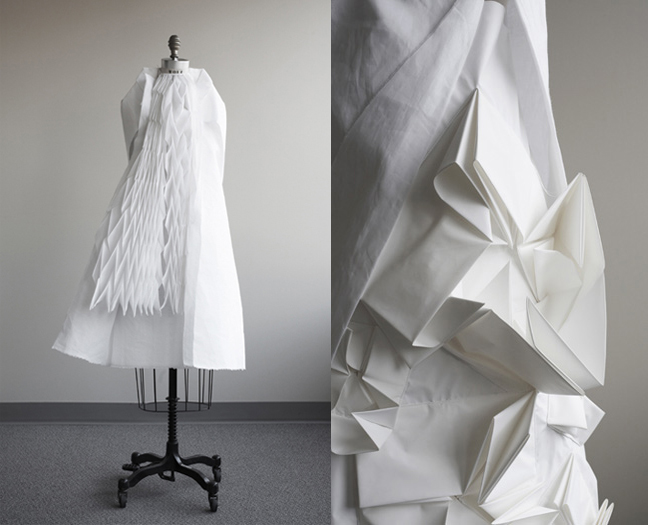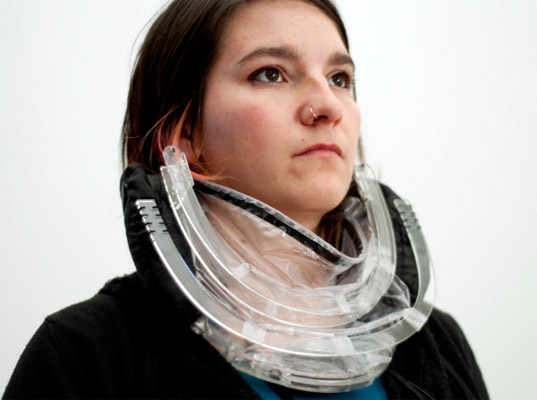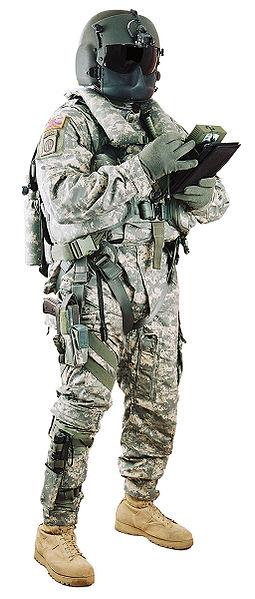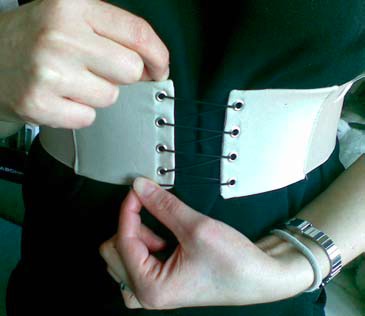Unknown Armature: “Breathe” (Hendren & Sherman)
by Sara
Unknown Armature: Breathe
For the final project, we’re planning a wearable vest that registers and actuates based on the inhalation and exhalation of breath in the wearer. Our “Breathe” jacket is imagined as an inversion of typical protective gear—for example, a bullet-proof vest. “Breathe” externalizes an interior system by sensing and registering the pattern of inhale and exhale in the wearer via stretch sensors; the jacket then actuates this data in light patterns. Rather than shield its wearer from harm, “Breathe” points back toward the body and its idiosyncracy, rhythmic reliability and frailty at once.
First, here are some precedent projects that are interesting to consider when looking at the range of breathing-apparatus wearables. Some draw from the wearer’s breath itself; others traffic in “breath” as a metaphor or conceptual source for other data.
Synne Geirsdatter Frydenberg’s LEDPneuma dress. This is the most obvious connection to our own project, and there are nice construction choices here.
DetectAir: A garment that senses air quality. From the Fashioning Technology profile:
Designed by Industrial design students Genevieve Mateyko and Pamela Troyer at Emily Carr University of Art + Design, the vest contains sensors that detect the ambient air quality and displays the data on the garment itself by illuminating a pattern of embedded LEDs across the chest.
Dan O’Sullivan’s Breath-Sensing Bra measures breath changes and temperature as well.
Jessica Floeh’s ExChange is a networked-breath project, wherein one wearer’s breath is registered and actuated by a partner’s breath-apparatus as well.
Ying Gao’s Living Pod and Walking City are garments that themselves seem to breathe—they operate irrespective of the wearer’s breath, but their response to light or wind makes their constituent parts seem to inhale and exhale, pulse with life. (Relevant footage starting at about 4:45.)
Anna Salmi’s “Aer” project. This is another spot-on precedent for our project; the garment registers the breath of the wearer and augments its changes with auditory signals. (Alas, no video for this anywhere, but here’s a link to her thesis pdf.)
And this is Pedro Andrade and Martina Pagura’s W ¦ Air. According to the Ecouterre profile, it’s “an oxygen-filtering breathing ‘necklace’ that removes carbon dioxide from the air, stores it in a battery-like device, and then converts it into electricity for later use.”
So, as expected, there are precedents. But what else could this kind of project be about? The act of breathing made visible carries with it poetic valences that could be emphasized and played with via actuators. What kind of garment would create a metaphor, some kind of meaning or exchange between those wearing it and those watching the (performative) wearer? It would be something that could be donned by anyone, in a public environment, and experienced. We’re thinking of a dialogue with other kinds of technologies:
Like this exoskeleton technology from Berkeley Bionics, which is making walking possible for paraplegics. The exoskeleton creates an armature for walking that fits around the body; it externalizes all the mechanisms for walking with high-tech materials, rather than trying to address an injury from its internal locus in the spine. This kind of machinery seems to register the future for all kinds prosthetics, and the advances in the field are astounding.
The exoskeleton is also being explored for use in tactical military gear, part of a larger set of plans for the U.S. military’s Future Force Warrior:
In this design, the exoskeleton amplifies an abled-walker’s power by up to ten times ordinary capacity. We’re interested in the exoskeleton, and in the other kinds of armature of a military nature, for their expressions of power—their networked shielding capacity that seem to make the body irrelevant or inconvenient:
Again, these technologies work to conceal and shield bodily systems for the purposes of combat. But what would an exoskeleton with a different challenge look like? What would be the reaction to an externalized wearable breathing apparatus on the public street? This is what we’re setting out to make and test.
It’s inspiring to look at Takehito Etani’s Masticator, a pig-skin and bones creation that externalizes the act of chewing and, thereby, the visceral and often embarrassing facts of bodily function. How might technologies point us back to the body, rather than hiding it away?
We’re going to use stretch-sensing rubber to measure the intake of breath, and use that register to then actuate a responsive wearable vest or jacket.
We’re acquiring some of this SkinBag material: a stretchy, sewable polymer that simulates human flesh…
…and can be molded and used in a number of different forms:
Here’s a first sketch for our design: a shell beneath, with a stretch panel for the sensor, circuitry, and connections to actuator lights:
And we may be able to benefit from the research of Anna Salmi in creating some elegant use of stretch rubber for the sensor-circuit construction:
(These images are from Salmi’s thesis project paper, PDF for which is linked here.)





















[...] Here’s a description and shot of our working “final” prototype of our breath sensor skin suit, which we proposed earlier this semester here. [...]